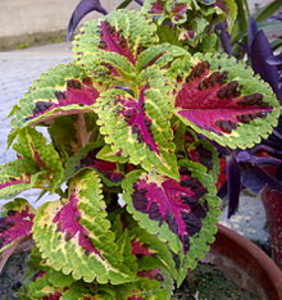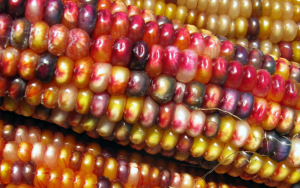By Jenna Beam
If I had to pick a theme for the coronavirus lockdown, it would be a close race between sourdough bread and houseplants. It seems like everyone either has a sourdough starter, approximately 100 new houseplants, or both. Since I’ve already written an article about sourdough bread (you can check it out here), today I’ll be talking about houseplants. Not just any houseplants, however. My absolute favorite subcategory of houseplants: variegated plants.
As you can see in Image 1, variegation is the appearance of two or more colors on the leaves, and sometimes stems or flowers, of plants. Variegation can also refer to distinct colors on the skin, fur, feathers, and scales of animals. Variegation is pretty rare in nature, but it most often occurs in smaller plants found in rainforests. These small, tropical plants, like the rubber plant, are common houseplants, so houseplants often display variegation.
Now let’s talk some biology. What causes variegation? There are a couple different ways this can happen. Plant cells have a special organelle called the chloroplast, which houses chlorophyll. Chlorophyll is a green pigment molecule that absorbs light to use as energy in photosynthesis. Not only is chlorophyll essential for photosynthesis to occur, it’s also the reason why plants appear bright green. In variegation, there’s been a mutation, or a change, in the cell that causes the chloroplast to either be missing, or prevents the chlorophyll from functioning properly. Mutations like this cause the leaves to appear both green and white. Since it’s a genetic mutation, this green and white coloring can be passed onto future generations of the plant.
Mutations in other pigments, such as anthocyanins, can also result in variegation. Common plants that are rich in anthocyanin include blackberries, blueberries and eggplant. When mutated, these pigments take over the natural green color of plants, making them look reddish, purple or even blue. The pigments may take over the whole leaf, or just parts, like in the Coleus plants seen in Image 2.
Variegation can also occur when a plant is infected with a virus. One example is Hosta Virus X (HVX), which infects hosta plants. It was first identified in Minnesota in 1996 and causes the leaves of hosta plants to look splotchy. Luckily, this virus doesn’t kill the plants, it just leads to interesting color patterns on the leaves. These patterns are so cool, that plant nurseries sometimes intentionally buy and sell HVX infected plants!
Variegation can occur a couple other ways, including through transposons, or “jumping genes.” These small pieces of DNA were identified by Barbara McClintock when she was working with Indian Corn. Transposons randomly move around the chromosome, causing “genetic mosaics” or what look like splashes of color!
Variegated plants are pretty cool, but the genetics underlying these colors might be even cooler! If you’re interested in taking up houseplants as a hobby, consider adding a variegated varietal to your collection.
Edited by Rami Major and Zoe Terwilliger



